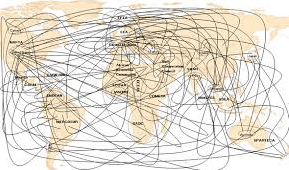
So it’s official. As reported by Houses & Holes earlier this morning, the new Federal Government “has backed fast, practical trade deals with individual countries, including China, in an apparent shift away from the last government’s efforts to win comprehensive international agreements”.
The move towards so-called “free trade agreements” (FTAs) – essentially binding bilateral pacts between countries that provide preferential access to each other’s markets (e.g. lower tariffs) – aligns the new Government with the former Howard Government, which negotiated bilateral trade deals with Thailand, Singapore, and the United States in the early-to-mid 2000s.
While FTAs have the potential to provide some modest trade benefits, there are also a number of reasons to be wary of pursuing them on economic efficiency grounds.
First, an FTA with a trading partner that is not the lowest cost producer risks creating “trade diversion” – effectively a situation whereby the importing country shifts its buying from a more efficient, lower cost country whose goods are subject to a tariff towards the less efficient and higher cost FTA partner whose goods are not subject to a tariff. In such circumstances, the importing country loses the tariff revenue, whilst its consumers do not fully benefit from a price reduction, potentially making them worse-off.
In order to explain, consider the below stylised example.
Country A imposes a 10% tariff on motor vehicles and, prior to the FTA, imports these vehicles at a cost of $20,000 from the World, taking the total import cost to $22,000, and earning its government $2,000 per vehicle in tariff revenue.
Country A then negotiates an FTA with Country B, who is less efficient at producing motor vehicles, and can produce a virtually identical car for $21,500.
After the FTA is concluded, Country A shifts its car purchases from the World to Country B. As a result, the total import cost of motor vehicles into Country A falls to $21,500, providing consumers with a benefit of $500 ($22,000 less $21,500). However, the government loses $2,000 in tariff revenue, making Country A worse-off overall.
Obviously, this is simple stylised example only, designed merely to highlight one of the potential costs of FTAs via trade diversion. But these efficiency costs can be real, especially when FTAs are negotiated with parties that are not world’s best producers in goods and where high tariffs exist (e.g. clothing and footwear).
Another cost associated with FTAs is the complex rules of origin (ROO) that are typically attached to such agreements. ROOs are designed to stop imports coming from third party (non-FTA) countries via an FTA partner, in order to circumvent tariff requirements. The ROOs, which can be either based on value-added requirements (i.e. the percentage of value-added by the FTA partner) or product specific (i.e. individual rules for each individual product imported), can raise administrative costs for businesses (including complying with paperwork requirements) and custom services in administering and auditing the ROO, undermining the benefits from the FTA.
The costs associated with ROOs will be greatest where there is a large number of FTAs each with different requirements, resulting in a “spaghetti bowl effect” of increasing complexity.
Obviously, the first best option in trade policy is to seek trade liberalisation at the multilateral level, whereby all parties agree to drop trade barriers all at once. However, such liberalisation has proved time and again next to impossible, with successive multilateral trade negotiations collapsing during the 2000s.
With multilateral liberalisation off the agenda, this leaves bilateral liberalisation (as discussed above) or unilateral liberalisation. For mine, unilateral liberalisation is the second best option.
Most people wrongly view trade barriers, like tariffs, as merely a negotiating coin that can be traded-off in exchange for other nations dropping their trade barriers. However, such a view is misplaced – trade barriers impose real costs on the domestic economy, both to consumers in the form of higher prices and to productivity overall by reducing competitive pressures.
Reducing one’s own trade barriers, therefore, not only improves outcomes for consumers via lower prices, but also increases competitive pressures on domestic industry, helping to spur greater innovation and productivity in order to survive.
In my view, Australian trade policy and trade liberalisation needs to be viewed more in this light – as a form of domestic competition policy, rather than something that can be traded away for a bunch of questionable bilateral deals with spurious efficiency impacts.

